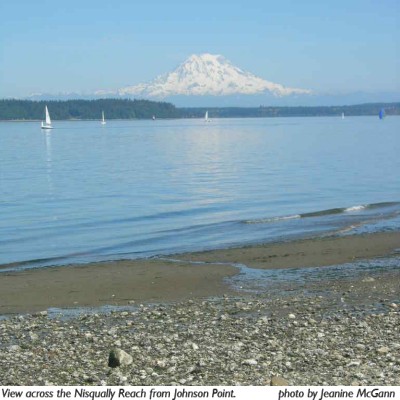Your Home Building Choices Can Help Puget Soundby Rachael Jamison The built environment plays a major role in easing climate change. A tremendous amount of energy (pun intended) has been put into educating homeowners on ways they can reduce their carbon footprint by increasing their homes' energy efficiency. As energy-efficient or 'green homes' have become more common and demand for green homes has continued to rise, many other environmental benefits of green building are now coming to light. Green building projects often use low-impact development (LID) strategies to achieve green building 'credits' for water use reduction and storm-water management. Low-impact development is defined in the Urban Design Tools' LID Manual as: "...an innovative stormwater management approach with a basic principle that is modeled after nature: manage rainfall at the source using uniformly distributed decentralized micro-scale controls. LID's goal is to mimic a site's predevelopment hydrology by using design techniques that infiltrate, filter, store, evaporate, and detain runoff close to its source. Techniques are based on the premise that stormwater management should not be seen as stormwater disposal." When building a new house or remodeling your existing home, the choices you make can help restore, or at least not contribute to the further degradation of Puget Sound. The following are several LID strategies common in green building practices that reduce a site's stormwater footprint. Pervious Concrete/Pavers Much of the natural landscape in the Puget Sound region has been covered by roads and parking lots. Most concretes and asphalts are impervious–that is, they don't allow natural water filtration. The result is increased stormwater runoff and contamination 'loading into' the Sound. When putting in sidewalks, driveways or patios, consider using pervious paving materials. These materials allow water to seep back into the ground, recharging groundwater and reducing run-off. Rain Gardens/Bio-retention Ponds A rain garden is a planted depression often populated with native plants that require little maintenance; they allow runoff from impervious areas to be absorbed and filtered on site. When planning a garden or landscaped area, consider a rain garden. Washington State University has developed a rain garden handbook for Western Washington; it can be found at: http://www.pierce.wsu.edu/Water_Quality/LID/Raingarden_introduction.pdf Green Roofs/Eco-roofs Green roofs "consist of a waterproof membrane that is covered by a drainage system, lightweight growing medium, and plants," according to the U.S. Environmental Protection Agency. When considering alternatives for a new roof for your home, be sure to explore the option of a green roof, also called a vegetated or eco-roof. Benefits of such choices include improved on-site stormwater management, greater energy efficiency and reduction of the 'heat island effect.' Rainwater Catchment System Rain barrels capture and store rooftop runoff for use in gardens and lawns. They are easy to maintain and low-cost. Large rainwater catchment systems (also called cisterns) may require a water rights permit. If you are looking into a commercial scale rainwater catchment system (5,000 gallons or more), be sure to contact staff at the state Department of Ecology. As readers of this publication surely recognize, we are currently faced with unprecedented environmental challenges. Even the small choices we face each day can either contribute to the solutions or magnify the problems. These times require being thoughtful about everything from the foods we eat, to the gardens we plant, to the ways we build and remodel our houses. We can create homes that are both safe havens for family and friends, and that also contribute to the restoration of our environment. Rachael Jamison is the Green Building Coordinator at the Washington Department of Ecology. She has worked on sustainable development issues in Washington for the past 10 years. For more information on the Ecology Green Building Program, call (360) 407-6352 or visit: http://www.ecy.wa.gov/programs/swfa/greenbuilding
Back to Home page. |

